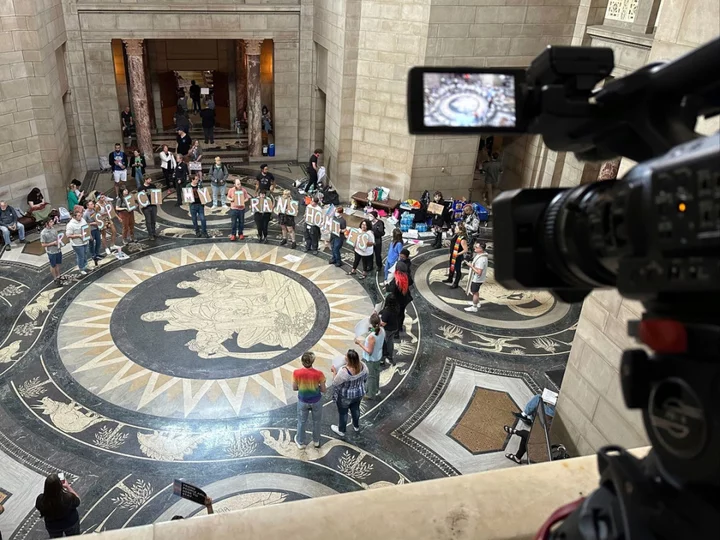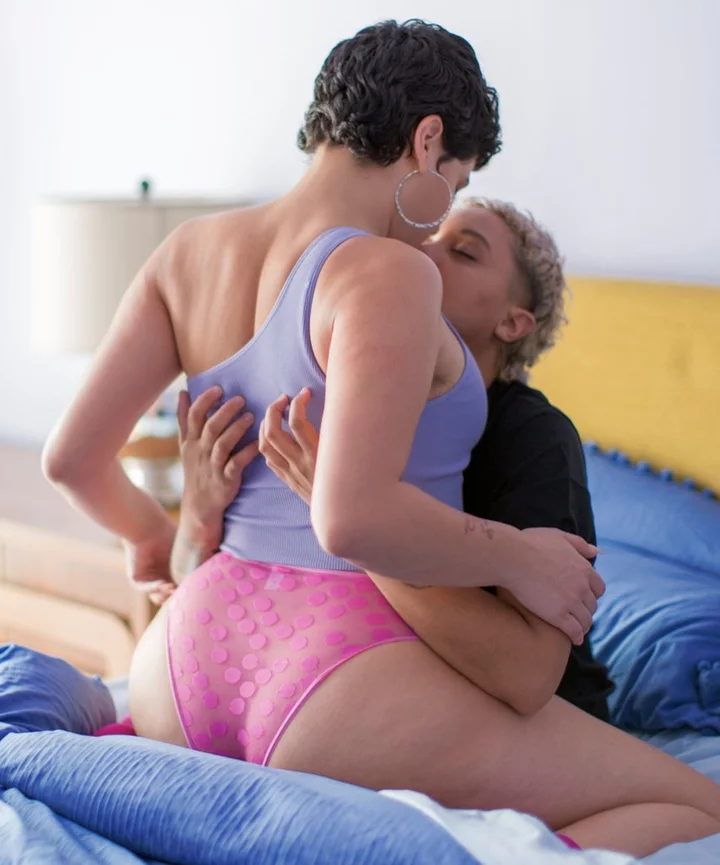We've been waiting almost two seasons to say this: "The gang's all here."
Well, the surviving Wiskayok High School Yellowjackets (that we know about) have now converged on Lottie's cult "intentional community", with grown-up Taissa (Tawny Cypress), Van (Lauren Ambrose), and Shauna (Melanie Lynskey) joining Natalie (Juliette Lewis) and Misty (Christina Ricci) at our Antler Queen's woodland retreat.
Instantly, Lottie (Simone Kessell) decides it's time for treatments all 'round for her best and most traumatised girlfriends, leading the group to the compound's fancy smoothie bar to consult a menu of ambiguously named treatments: "Self Care," "Guidance," "Forage," and "Renewal."
Credit: Kailey Schwerman/SHOWTIME"When someone new comes in, we often let them choose a treatment without a description," Lottie explains to the group. "Just whatever speaks to them."
Without really knowing anything about what each person has been through over the last 15 years since being rescued, Lottie lets each teammate pick their own treatment without a personal consultation. Let's be honest; this is slightly irresponsible for someone managing a retreat claiming to treat mental health issues.
"Before diving into therapy," Mashable senior features writer Rebecca Ruiz writes, "it's worth reflecting on whether, for example, you're looking to develop better coping skills for sudden stressors, need help processing past physical or emotional trauma, assistance managing ongoing depression or anxiety, or maybe even all of those things."
SEE ALSO: 'Yellowjackets' Season 2: What's the deal with Lottie's cult?As it turns out, Lottie's alternative treatments are sometimes used in real life to complement other, more traditional mental health treatments offered by trained professionals, like talk therapy, cognitive behavioural therapy (CBT), and eye movement desensitisation and reprocessing (EMDR) (which Lottie uses with Natalie in episode 5).
Shauna picks "Self Care," Misty goes for "Guidance," Van opts to "Forage," and Taissa chooses "Renewal." As it turns out, each character magically selects the modality that speaks most directly to her core wound. Let's unpack each one and see how they work.
Shauna: Self Care
Credit: Kailey Schwerman/SHOWTIMEAs the Yellowjacket who most embodies the "please scream inside your heart" approach to life, Shauna picks "Self Care." Not just bubble baths or social media fodder, self-care itself is the act of looking after yourself — the practice of taking time to reflect, assess, and restore our mental, emotional, and physical health, which can vary from person to person. As Mashable editor Chris Taylor puts it, "Self-care isn't performative self-coddling. It's doing the hard work of examining and improving yourself in order to better serve the world."
Shauna's treatment brings her to a barn full of animals, where she's presented with a baby goat named Bruce to care for all day.
"This is self-care? I was expecting a massage or maybe a mud bath with some self-reflective questions," she asks. With Bruce, Shauna's tasked with a form of animal-assisted therapy, which in real life can help with many mental health issues, including anxiety and depression.
"Self-care means taking care of the goat for the rest of the day, and thus experiencing all the personal discoveries and sacrifices that go along with doing so," Lottie's follower explains. "All the insight required resides within the self. The kid's care is entwined with your own."
SEE ALSO: 5 tips for starting a conversation about your mental healthIt's no coincidence Shauna is given a baby goat or kid to care for, which brings up complicated emotions and suppressed trauma given her son's stillbirth in the wilderness. The instructor's comments about sacrifice do not sit well with Shauna, as someone who has experienced this in ways the person trying to hand her a goat could never have dreamed; she even anticipates Lottie will force her to kill the goat at the end of the treatment, after they've bonded.
"I find it gives a person clarity to care for something so innocent," Lottie says, ensuring there'll be no animal sacrifices today.
But the task of caring for a kid also causes Shauna to reflect on her complicated relationship with her daughter Callie in the present. "I'm not crying about the goat," Shauna acknowledges to Lottie, before digging into her deliberately limited connection with Callie, and her fear of losing her — "or that maybe she was never even real to begin with." Shauna realizes she doesn't feel safe to think of Callie as hers after her traumatic loss in the wilderness, and it's the first time we've really seen her acknowledge this in the series. Bruce worked wonders.
Misty: Guidance
Credit: Kailey Schwerman/SHOWTIMEMisty's treatment, one Lottie deems her favourite, is about "Guidance," specifically through floatation therapy in a sensory deprivation tank, clothing optional.
"The most authentic guidance comes from within," Lisa tells Misty, who seems deeply unconvinced this is the treatment for her.
"So, I'll just be inside that water coffin in the dark, all by myself?" Misty asks.
Floatation and sensory isolation is a therapeutic treatment used to reduce anxiety and manage stress — you might remember it used as a narrative device in Stranger Things, as El uses it to relax and enter her own mind palace. Misty has murdered multiple people, both in the wilderness and far more recently, so confronting one's inner thoughts in a sensory deprivation tank seems like an understandably confronting exercise to her. What exactly will be unearthed? But when we're allowed inside Misty's brain, what we find is surreal to us and deeply euphoric for Misty.
Misty rarely thinks she needs guidance, if ever. From the moment she emerges from the crashed plane to the cover-up of Adam's murder, Misty knows exactly what to do in most circumstances. Sure, her moral compass could use a little tweaking, but her self-serving instincts certainly keep her alive. In this moment in the darkness in Lottie's pod, with all her surviving Yellowjackets teammates reunited nearby, she takes guidance in the form of an anthropomorphised Caligula (played by the delightful John Cameron Mitchell) dancing to a show tune with Walter, who wears a top hat and tails.
"Caligula, when people look at me, do they just see someone desperate for love? Just some murderer?"
Featured Video For You Watch the 'Yellowjackets' cast absolutely crush Mash LibsMisty desperately wants to be needed and appreciated, and she truly believes that like her bird's namesake, she's been "unjustly accused of heinous acts." Her subconscious, in the guise of Caligula, tells her, "How much do we all count on you? How many times did you get the ball over the goal line?" But Misty's subconscious also makes her feelings for Walter clear; as soon as her float is over, she goes straight for the landline and leaves a regrettably long, stream-of-consciousness voicemail declaring them.
So, while you might initially think Misty will gain clarity on the error of her questionable ways through this floatation therapy, or even begin to address her own trauma from the wilderness, instead it solidifies her big-time crush and belief that no, it's the children who are wrong.
Taissa: Renewal
Credit: Kailey Schwerman/SHOWTIMETai's chosen treatment is "Renewal," which requires her to paint a large exterior cabin wall with a tiny makeup brush. Art therapy is an established form of psychotherapy often conducted in groups, and although this doesn't exactly seem to be what Lottie is offering here, it could be a good option for Tai. But unfortunately, Tai's basic version of this treatment doesn't really match what she actually needs.
Art therapy, when run by trained psychotherapists, "help[s] people deal with complex and confusing emotional issues. There may be things which clients cannot say in words. This could be because the emotions are too distressing or because the client has difficulties with communication." Sounds about right for Taissa, whose biggest issue (beyond her past path of plane crash to ritual cannibalism) is her "other self" who emerges through Tai's sleepwalking and communicates through violent means. And notably, Taissa's son Sammy has used enough art therapy of his own to process this. Renewal is what Taissa craves indeed.
Needless to say, Taissa doesn't get very far with her painstaking cabin painting; after painting a small square yellow and scrawling "FUCK" in paint, she bails. "Can we cut through the bullshit? Because me painting this whole building with a fucking makeup brush isn't exactly solving all my problems." Lottie's answer? Instantly pivoting to talk therapy, which Taissa responds to possibly because the seemingly useless task of painting a wall has encouraged her to cut the crap and get straight to what's actually causing her pain. Within seconds, it becomes apparent Taissa needs more than this DIY house painting treatment for a real sense of renewal.
Van: Forage
Credit: Kailey Schwerman/SHOWTIMEWhether Lottie was going to have Van roam the compound grounds for wild plants or whether she was sending her for a stint of forest bathing, the Japanese eco-therapy relaxation practice, we never find out, but we see Van's modern interpretation of the treatment "Forage."
"I chose 'Forage' from Lottie's weird chore chart, and so I went to my truck and did exactly that," Van says, brandishing a large, already-started bottle of tequila. Van has plenty to process: She survived the plane crash, despite being trapped by her own seatbelt and left behind by her teammates in a burning plane, not to mention a horrifying wolf attack and almost two years in the wilderness, only to come back and receive a diagnosis of terminal cancer. So, yeah, digging up mushrooms or whatever on Lottie's property is not a priority for Van.
Arguably, Van's boozy interpretation of Lottie's treatment opens the group up, as they eventually find each other and end up drinking, dancing, talking about crushes and hookups, and importantly, almost speaking about what happened in the wilderness. As Florence and the Machine booms, it's the first time this entire series the Yellowjackets are able to let go, laugh, and take a moment away from everything.
Credit: Kailey Schwerman/SHOWTIMELottie is able to get through to Shauna, Taissa, Natalie, and Misty, while Van remains a cynic. But Van was one of Lottie's supporters in the wilderness, so exactly what happened between them remains a mystery for future episodes.
One thing remains clear for them all: Not one Yellowjacket has adequately processed their wilderness trauma. Lottie comes the closest, as someone who seems to see a therapist and take medication regularly, but she remains haunted by her Antler Queen past. Having self-medicated in the past, Natalie has renewed her sobriety journey at Lottie's retreat, and she encourages the others to do the same, to actually begin to address the "dark shit" they experienced in the wilderness.
But it's clear Van, Shauna, and Taissa haven't even begun to address their trauma, and are valiantly trying to leave it in the woods from whence it came. Who can blame them? Starting a conversation about your mental health can be intimidating enough without knowing you might have to unpack that one time you ate your best friend.
Yellowjackets Season 2 is streaming on Showtime, with new episodes streaming weekly on Fridays. Episodes also air every Sunday on Showtime at 9 p.m. ET.









